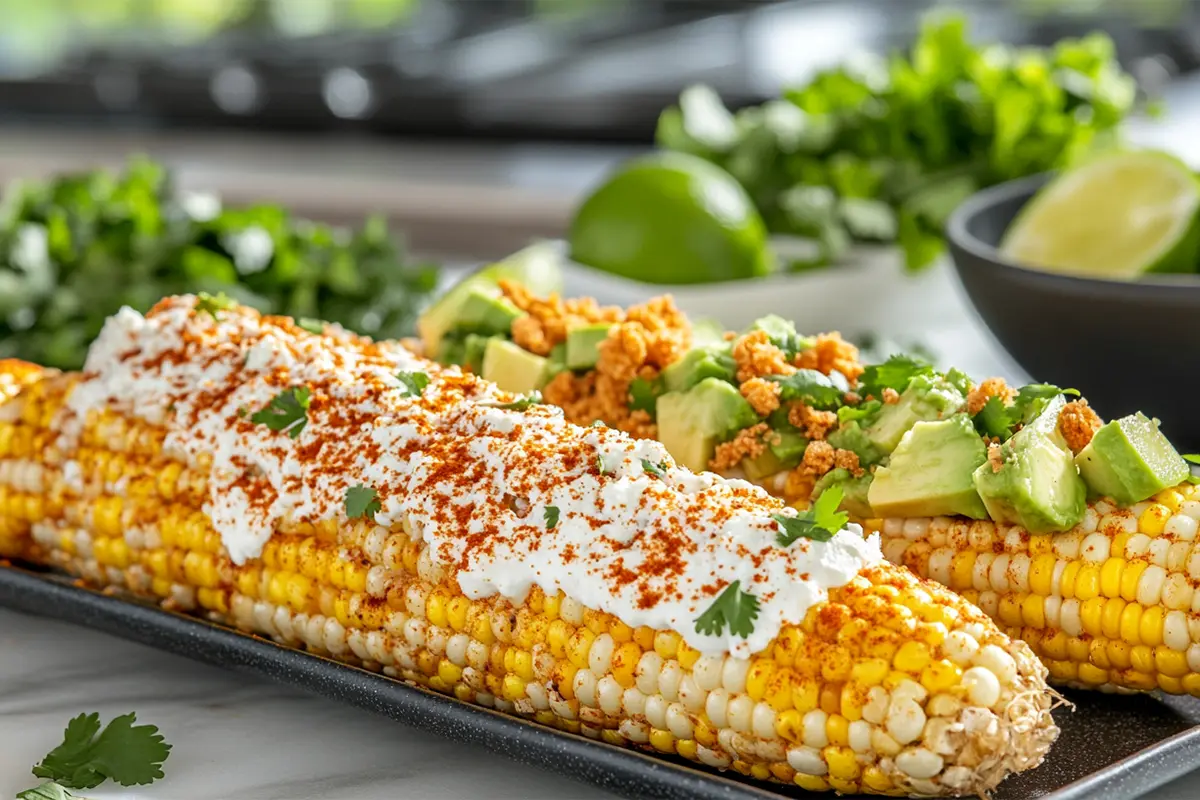Mexican street corn, known as elote, is more than just a popular snack—it’s a cultural icon. The combination of flavors and textures in elote creates a culinary experience that’s hard to resist. But what exactly makes Mexican street corn so good? This article explores the ingredients, cultural significance, and unique qualities that contribute to the undeniable appeal of this beloved dish.
Introduction to Mexican Street Corn
Mexican street corn is a traditional Mexican dish typically served on the cob, grilled, and topped with a variety of flavorful ingredients. The most common toppings include Cotija cheese, mayonnaise, chili powder, and lime juice, all of which combine to create a dish that is sweet, savory, creamy, spicy, and tangy all at once.
Elote is a staple in Mexican street food culture. Its popularity has spread beyond Mexico’s borders, making it a favorite in many parts of the world. But what is it about this simple dish that has captured the hearts of so many? To understand, we must explore both the ingredients and the cultural roots of elote.
History of Mexican Street Corn
Elote has deep roots in Mexican culture. Corn (maize) has been a dietary staple for thousands of years. Corn was domesticated in Mexico around 9,000 years ago, and it has played a central role in the region’s cuisine ever since. In ancient Mesoamerica, corn was not only a primary food source but also held religious significance.
The tradition of grilling corn and adding toppings likely began in rural areas of Mexico, where fresh corn was abundant. Over time, this practice made its way into urban areas, becoming a popular street food in cities across Mexico. Today, elote is enjoyed by people from all walks of life, from roadside vendors to upscale restaurants.
If you’re interested in the historical significance of corn in Mexican cuisine, you can learn more by highlighting this Wikipedia article. Additionally, the rich history and diversity of Mexican cuisine can be further explored through this Britannica entry.
Ingredients that Make Mexican Street Corn Unique
The magic of elote lies in its ingredients, each of which contributes to the dish’s unique flavor profile.
Corn
At the heart of elote is fresh corn on the cob, typically grilled or roasted to bring out its natural sweetness. The grilling process caramelizes the sugars in the corn, enhancing its flavor and adding a slight smokiness that complements the other ingredients.
Cotija Cheese
Cotija cheese is a staple in Mexican cuisine. This crumbly, salty cheese adds a savory depth to elote that balances the sweetness of the corn. Named after the town of Cotija in Michoacán, Mexico, this cheese is often referred to as the “Parmesan of Mexico” due to its strong, tangy flavor.
Mayonnaise
Mayonnaise might seem like an unusual ingredient, but it plays a crucial role in elote. The creaminess of the mayonnaise helps to bind the other toppings to the corn while adding a rich, velvety texture. Some variations of elote use a mixture of mayonnaise and Mexican crema for an even creamier topping.
Chili Powder
Chili powder adds a spicy kick to elote, balancing the sweetness of the corn and the richness of the cheese and mayonnaise. The heat level can be adjusted to taste, making it a versatile ingredient that can appeal to both mild and spicy palates.
Lime Juice
Lime juice is the finishing touch on elote, adding a burst of acidity that brightens the entire dish. The tanginess of the lime cuts through the richness of the cheese and mayonnaise, providing a refreshing contrast that makes each bite of elote irresistible.
Cilantro
Finally, a sprinkle of fresh cilantro adds a herbal note to elote, complementing the other flavors and adding a pop of color. While cilantro is optional, it’s a common garnish that enhances the dish’s visual appeal and flavor complexity.

The Cultural Significance of Elote
Street Food Culture in Mexico
Street food is an integral part of Mexican culture, offering a quick and affordable way to enjoy traditional dishes. Elote, sold by street vendors known as eloteros, is one of the most popular street foods in Mexico. These vendors often push carts through neighborhoods, serving elote to customers directly on the street.
Elote as a Symbol of Mexican Identity
Elote is more than just a snack; it’s a symbol of Mexican identity and pride. The dish reflects the resourcefulness and creativity of Mexican cuisine, turning simple, everyday ingredients into something extraordinary. For many Mexicans, elote is a nostalgic reminder of childhood and community, making it a dish that is cherished across generations.
Regional Variations
While the basic elements of elote remain consistent, there are regional variations that reflect the diverse culinary traditions of Mexico. In some regions, elote is served with additional toppings like crushed hot Cheetos, smoked paprika, or even avocado. In others, the corn may be boiled rather than grilled, resulting in a softer texture.
Modern Adaptations
Elote has also been adapted in other countries, where it has inspired new variations and fusion dishes. For example, elote-inspired salads, dips, and even pizzas have become popular in the United States. These modern adaptations demonstrate the versatility of elote and its ability to transcend cultural boundaries while maintaining its essential flavors.
For a delicious twist on traditional elote, check out this recipe for Mexican Street Corn Dip, which offers a unique take on the classic flavors.
Flavor Profile of Mexican Street Corn
The flavor profile of Mexican street corn is a harmonious blend of sweet, salty, creamy, spicy, and tangy elements, making it a complex and satisfying dish.
Sweetness of Corn
The natural sweetness of fresh corn is the foundation of elote. Grilling or roasting the corn enhances this sweetness by caramelizing the sugars, creating a rich, deep flavor that contrasts beautifully with the savory and spicy toppings.
Salty and Creamy Elements
The combination of Cotija cheese and mayonnaise adds a rich, salty, and creamy element to elote. The cheese provides a sharp, tangy flavor, while the mayonnaise adds smoothness and helps the other ingredients adhere to the corn.
Spicy and Tangy Notes
Chili powder and lime juice add the final touches to elote, providing a spicy and tangy contrast that elevates the dish. The heat from the chili powder is balanced by the acidity of the lime juice, creating a dynamic flavor profile that keeps each bite interesting.
Textural Contrast
One of the reasons elote is so satisfying is its textural contrast. The crispness of the grilled corn kernels contrasts with the creamy mayonnaise, crumbly cheese, and smooth lime juice, creating a multi-dimensional eating experience.
How to Make Authentic Mexican Street Corn
Making authentic elote at home is easier than you might think. Here’s a step-by-step guide to help you recreate this delicious dish.
Choosing the Right Corn
Start by selecting fresh, high-quality corn. Look for ears with bright green husks, plump kernels, and no signs of drying. Fresh corn is essential for achieving the best flavor and texture in your elote.
Grilling vs. Roasting
Grilling is the traditional method for making elote, as it imparts a smoky flavor that enhances the sweetness of the corn. However, if you don’t have access to a grill, roasting the corn in the oven is a great alternative. Simply preheat your grill or oven to medium-high heat, and cook the corn until it is tender and charred in spots.
Assembling the Elote
Once your corn is cooked, it’s time to assemble the elote. Start by slathering each ear of corn with a generous layer of mayonnaise. Next, sprinkle the Cotija cheese evenly over the mayonnaise, ensuring that the cheese adheres to the corn. Add a dash of chili powder for heat, followed by a squeeze of fresh lime juice. Finally, garnish with cilantro, if desired.
Serving Suggestions
Elote is traditionally served hot, directly from the grill or oven. It makes an excellent snack, side dish, or even a light meal when paired with a salad or other accompaniments. Serve the elote with extra lime wedges and chili powder on the side, allowing your guests to customize their corn to their liking.
To explore the ingredients in similar dishes and how they compare, you might want to learn more about the essential ingredients in Mexican corn dip and how they contribute to its unique flavor.
FAQs about Mexican Street Corn
What makes Mexican street corn different from other corn dishes?
Mexican street corn is distinct because of its combination of ingredients and cooking method. The use of Cotija cheese, mayonnaise, and chili powder, along with the grilling process, sets it apart from simpler corn dishes like boiled or buttered corn.
Can you make Mexican street corn with other types of cheese?
Yes, while Cotija cheese is traditional, other crumbly cheeses like Feta or Parmesan can be used as substitutes. However, these cheeses will alter the flavor slightly, with Feta providing a tangier taste and Parmesan adding a nutty note.
Is Mexican street corn served hot or cold?
Mexican street corn is typically served hot, right after it has been grilled or roasted. The heat helps to melt the cheese slightly and enhances the flavors of the toppings.
What are some popular variations of Mexican street corn?
Some popular variations include adding crushed hot Cheetos, smoked paprika, or avocado as additional toppings. Another variation is serving the corn off the cob, mixed with the toppings to create a dish known as esquites.
How can you make a healthier version of Mexican street corn?
To make a healthier version of elote, you can substitute Greek yogurt for mayonnaise and use a reduced-fat cheese. Grilling the corn without butter and controlling the portion size of the toppings can also help reduce the calorie count.
Discover creative ways to enjoy Costco’s Street Corn Dip, which captures the essence of traditional elote, by reading this article.
Conclusion
The combination of sweet corn, salty Cotija cheese, creamy mayonnaise, spicy chili powder, and tangy lime juice creates a flavor explosion that makes Mexican street corn so irresistibly good. Beyond its deliciousness, elote is a dish steeped in tradition, culture, and community, making it a symbol of Mexican culinary excellence. Whether you enjoy it on the streets of Mexico or make it at home, elote is a dish that offers a taste of the vibrant flavors and rich history of Mexican cuisine.
For more information on the cultural and culinary significance of elote, you can explore this Wikipedia article. Additionally, the Mexican cuisine provides a deeper dive into the history and evolution of Mexican food.

